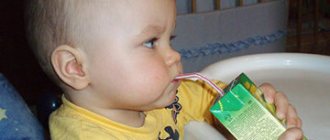The sucking reflex in newborns is inherent in nature. From the first minutes of life, it is recommended to put the baby to the breast to calm him down after the birth process and the stress he has experienced. But sometimes it is impossible to do this - complicated childbirth, caesarean section and general anesthesia, premature birth. The woman is forced to remain in bed, and at this moment the child is fed formula from a bottle in the children's department or is kept in a special box.
Then you don’t have to be surprised that the baby doesn’t latch onto the breast correctly, because with artificial feeding you don’t need to strain, formula saturates faster. Another thing is breastfeeding. This requires effort. Infants even develop specific blisters on the lower lip from regular feeding.
Why does a baby latch on incorrectly?
There are so-called “lazy people” who are simply too lazy to exert themselves and quickly fall asleep in the process. It is believed that in such children the hunger center in the brain matures later and they gain weight more slowly. But even this reason is not a reason to give up breastfeeding and you need to continue to breastfeed your baby regularly. Sooner or later, this nerve center will wake up, and the baby will begin to eat more actively.
How to get a newborn to eat
What prevents the baby from latching onto the nipple correctly:
- Alternate breast and bottle feeding. Sucking a pacifier. An incorrect latch is formed, which then affects breastfeeding.
- Stagnation of mother's milk. The longer the feeding process is delayed, the harder it is for the baby to take the first sip. Therefore, if the baby completely sucks one breast, then it is recommended to express the second a little. This is good for both the mother, since there is less risk of mastitis, and for the child.
- Incorrect posture. The chest may cover the baby’s nose and he will have no way to breathe. As a result, he will constantly open his mouth and twist around to breathe. The same thing happens when a baby has a runny nose.
- Cracks in the nipples and bleeding can change the taste of the milk, so the baby may refuse to eat. And the mixtures will be treated well.
The first thing mom needs to do is tidy up her breasts, using special ointments to heal wounds. At this point, the milk needs to be expressed so that it does not disappear completely. Some authors write that lactation can then be restored, but according to reviews on the forums, not everyone succeeded and had to be switched to artificial nutrition.
Second, stop giving bottles and pacifiers. Pacifiers are not so bad if your baby eats breast milk well. There are generalist children who eat from everything that is offered. It's good that the majority are like that.
Start feeding your baby on demand rather than on a schedule. This method is long gone. Children who are constantly close to their mother eat and sleep better. Co-sleeping also promotes better bonding and quick transition from bottle to breast.
What to do if your baby is used to feeding from a bottle?
We know how important breast milk is for a newborn. If for some reason the baby had to be fed from a bottle (for example, due to a difficult birth, illness of the mother, or her temporary separation from the baby), then the question arises - how to wean the breast after a bottle? After all, the process of breastfeeding is much more difficult for a child. It is unlikely that he will so easily give up such an easy way to eat.
An article for parents of older children on how to wean their child from the breast.
Advice from an educational psychologist for those parents who don’t know how to wean their child off the pacifier.
Start breastfeeding re-weaning by stopping the use of bottles, pacifiers and pacifiers. Throw them in the closet. A beaker, a spoon, a syringe - this is what will help in supplementary feeding if necessary.
It is completely normal for your child to be new to a new way of eating. It will take up to one week to get used to it. As is clear from the recommendations above, give him your breast as often as possible.
Read also
Twenty-ninth week of pregnancy: child development and mother’s well-being, possible problems
Do this at moments when the baby’s attention is not so active, namely at the moment of waking up or falling asleep. Point the nipple into his mouth.
At first you will not notice any sucking movements, but this is where the path to breast weaning begins. Reduce the frequency of feedings using other devices as soon as you notice success in breastfeeding. The baby will be grateful if he eats only breast milk before the due date for introducing complementary foods. You will succeed!
Proper latching of the baby to the breast
The fact is that the child does not suck well or refuse to eat. He has reasons for this, which he cannot tell his mother about. The problem can come from both the mother and the child.
From mom's side:
- the position for feeding is incorrectly chosen - the baby is far from the nipple, just hanging on it and trying to hold it;
- hard breast - the baby cannot suck in milk.
From the child's side:
- the baby is weakened or sick;
- premature baby;
- short frenulum - difficult to suck;
- facial muscle tone.
If the usual measures to retrain the baby do not have an effect, you need to consult a doctor. There are also breastfeeding consultants who will clearly show how to teach a child to latch on to the breast correctly. Usually such a person is invited home and in practice they find out what the problem is with the mother or child.
The correct attachment determines whether the baby will receive as much milk as he needs or will go hungry.
Choosing a feeding position
Of the common reasons, posture selection is the most common problem. Mom should be comfortable. To do this, you need to provide support for your back. If the process occurs while sitting, the elbows should also rest on something so that it is not difficult to support the child at the required distance from the nipple. Your feet should rest on a platform - a bench, a folded blanket on the floor, a bolster.
Convenient feeding of the baby:
- From under the arm, when the child’s body is located on the side of the mother on an elevated platform. Suitable for twins, allows maximum rest for the back while the baby eats. One hand is free and it is easy to use it to properly position the breast so that the nipple enters the mouth along with the areola.
- Lying down. More suitable for feeding before bedtime. The mother lies on her side, the baby is turned to face the chest. With your other hand, you can take and give the nipple several times until it is captured correctly.
- In the “cross cradle” position. The baby's head rests in the left hand on the right side. It is convenient to teach the right hand to take the breast.
Without additional support in the form of a pillow, relying only on the strength of her hands, it will be inconvenient for mom to control the process and she will quickly get tired. The traditional position of a baby in the arms with one shoulder raised by the mother is not suitable for “training” to latch onto the nipple.
Nipple latching rules
How should a baby breastfeed correctly:
- The nipple touches the roof of the mouth. You can check by putting a clean finger in your baby's mouth. He pulls it in and a vacuum is formed, making it difficult to remove this finger later. If this does not happen, the baby does not know how to suck properly.
- The nipple enters the mouth along with the areola. You just need to do this quickly, otherwise the baby may bite and injure the breast.
- Does not slide onto the nipple during feeding.
- There are no smacking sounds, only swallowing sounds.
- If you look from below, you can see the tongue located between the chest and lower lip.
- The chin moves and freezes in the down position while the baby draws in liquid.
Signs of an improper grip:
- extraneous sounds;
- the mouth is not open wide;
- the areola is visible, there is one nipple in the mouth;
- Mom feels pain.
Incorrect sucking results in the baby not receiving enough milk and acting restless.
How to resume breastfeeding?
Despite the variety of factors that provoke a child’s refusal to suckle at the breast and get used to the bottle, the mechanism of decisions and actions is always the same.
To eliminate the main cause and additional factors, it will take quite a lot of time and mother’s patience. The ideal option is to throw all the mother’s energy into weaning the baby off the bottle and returning to breastfeeding.
That is why it is extremely necessary to get the support of household members, since all other everyday problems should fall on the shoulders of the spouse, adult first-born child or grandmothers. Of course, you need to warn about this in advance.
What exactly should a mother do? Listen to the advice of breastfeeding experts and implement them correctly. Experts offer the following useful recommendations.
- It is necessary to put aside everything that the child can suck, of course, with the exception of the mammary glands. Such a radical step solves two problems at once. First of all, it is natural for a baby to strive to suck the breast, so in the absence of a pacifier and bottle, he will take the breast, which is what the mother wants. In addition, the factor of nipple disorientation is removed. The baby will remember how to grasp the nipple correctly and will return to the mother’s breast.
- A woman needs to constantly maintain close physical contact. This advice from experts on breastfeeding also applies to breastfeeding. When a mother carries her baby in her arms and touches his body with her skin, this leads to some useful responses. In the mother's body, when the baby is applied to the mammary gland, the amount of oxytocin increases, as a result of which milk is released more strongly. The baby develops the warmest feelings for his mother, he feels her love, protection and tenderness. That is, breastfeeding is the most important condition for optimal psychological health of children.
- For a certain period of time, it is better to remove household members from caring for the child. It is better to ask them for help in household chores, and only the mother is responsible for feeding, putting them to bed, performing water procedures, rocking them to sleep and carrying them in her arms. However, if the baby begins to cry when changing a diaper or after bathing, it is better to entrust this task to the father or another loved one. The point of such manipulations is that the child should not have any negative associations with his mother. This will significantly contribute to natural feeding.
- Experts on breastfeeding strongly advise reducing the time spent in public places while weaning off the bottle. This method involves constantly staying at home, in a familiar environment, next to your beloved mother. At the very beginning of returning to natural feeding, experts recommend excluding visits to guests, the hospital, shortening the duration of festivities, and even abandoning them altogether.
- It is imperative to give breastfeeding when the baby needs it most. So, a newborn is simply “obliged”, due to natural reflexes, to fall asleep with his mother’s breast in his mouth. That is why, before falling asleep, children usually do not resist breastfeeding. Another convenient time period is immediately after the opening of children’s eyes, when the child has not yet “activated”. In addition, nighttime meals are also beneficial for breastfeeding. They increase milk secretion and help restore the correct sucking reflex.
- A nursing woman needs to do everything to ensure that the baby feels comfortable and as comfortable as possible when receiving milk. Mom should try to feed the baby in any position - sitting, standing and lying on a barrel. Another option is to use a special pillow. In addition, it is necessary to eliminate any distraction - the sounds of the TV, for example. If you have cracks in your breasts or problems with your nipples, you can first try feeding your baby using special pads on which you can drip a little milk.
- There is no need to insist if the child categorically refuses the breast and reacts extremely negatively to the offer to suckle milk. You cannot be irritated, much less force your baby to grab the nipple by force. To promote natural feeding, you should show maximum tenderness, patience and affection. In case of a whim, the mother should simply calm the baby down and try again after some time.
- If the child has become accustomed to the bottle, it is necessary to return to natural feeding as soon as possible. However, a new parent needs to behave correctly, that is, avoid the bottle as much as possible. In the absence of other options, the child will simply be forced to satisfy all his reflexes through the mother's mammary glands. In the future, this will help establish a normal food intake process.
- Breastfeeding experts also advise sleeping with your baby. Falling asleep together promotes close interaction almost every minute, and also provides the baby with unlimited access to breast milk at night - precisely at that time period when the milk secretion is best separated. At the same time, breastfeeding promotes optimal rest, since the woman does not have to jump up due to the baby's crying.
Read also
Swimming for children under one year old: preparation and teaching methods, general principles of classes
However, this must be done correctly, having first established the reason for refusing breastfeeding and getting used to the bottle.
If the proposed steps did not help to retrain the baby, you should definitely contact your pediatrician. It is possible that the problems are associated with the anatomical features of the baby's oral cavity, intolerance to breast milk, or some other serious illness.
How to teach your baby to latch correctly
Techniques that help establish proper sucking:
- pressing on the chin so that the baby opens his mouth wider;
- finger feeding with a tube - used for mastitis in the mother, allows you to determine how well the baby sucks the finger correctly.
Some children need to be trained for a long time until they learn. According to mothers, some made 20-30 attempts per application. Training sometimes dragged on for a month or two. But if the mother does not stop trying, the children will sooner or later wean themselves to the breast.
Errors during training
Sometimes, when thinking about how to quickly accustom a child to breastfeeding, a mother does not take into account the possibility of mistakes. There are a number of actions that cannot be performed in order for training to be successful. Also, special attention should be paid to developing the application technique. Choosing a position that is comfortable for you and your baby is very important.
Incorrect application
Pressing too tightly, lack of support for the shoulders or head - all this refers to incorrect attachment. At this stage, you need to provide the child with freedom to choose a position (with control). In the found position, further feeding is carried out.
Read also
The most accurate symptoms and signs of multiple pregnancy and folk signs
What not to do
There are several prohibited actions during training for breastfeeding:
- use a pacifier;
- give a bottle;
- to be nervous;
- show impatience and anger.
On a note. The child senses the mother’s mood, so he may start crying in response. You should also not rush or make sudden movements.
How to tell if your baby is full of breast milk
Breasts gain weight more slowly - this is normal. The main thing is that the baby sucks the entire portion of milk regularly. To understand whether your baby has enough nutrition, you need to analyze:
- the amount of urine per day - if 4 - 5 diapers are changed per day, completely wet, then everything is in order;
- regular daily bowel movements - from 5 to 8 times a day;
- emptying of the mammary gland after feeding;
- The stool becomes a light mustard color by the third day after birth.
A well-fed baby sleeps better at night, although this sign is not decisive.
The main thing in breastfeeding is the mother’s persistence, which helps maintain natural nutrition, which subsequently affects the baby’s immunity. Therefore, you need to continue teaching the child to eat mother's milk until he succeeds.











